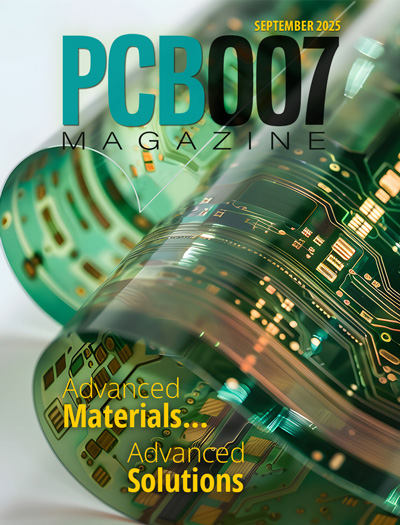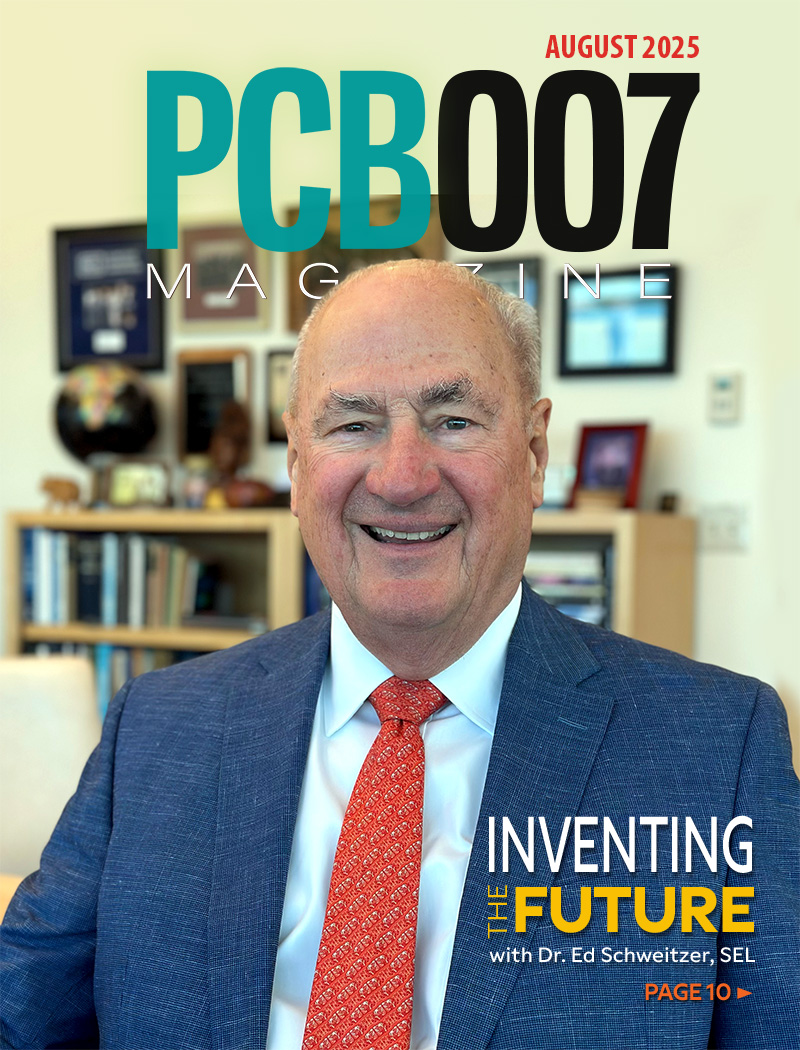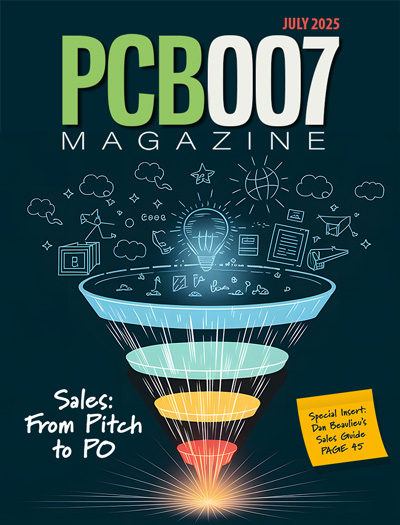-

- News
- Books
Featured Books
- pcb007 Magazine
Latest Issues
Current Issue
Advancing the Advanced Materials Discussion
Moore’s Law is no more, and the advanced material solutions to grapple with this reality are surprising, stunning, and perhaps a bit daunting. Buckle up for a dive into advanced materials and a glimpse into the next chapters of electronics manufacturing.

Inventing the Future With SEL
Two years after launching its state-of-the-art PCB facility, SEL shares lessons in vision, execution, and innovation, plus insights from industry icons and technology leaders shaping the future of PCB fabrication.

Sales: From Pitch to PO
From the first cold call to finally receiving that first purchase order, the July PCB007 Magazine breaks down some critical parts of the sales stack. To up your sales game, read on!
- Articles
- Columns
- Links
- Media kit
||| MENU - pcb007 Magazine
Scientists Harness Solar Power to Produce Clean Hydrogen From Biomass
March 14, 2017 | University of CambridgeEstimated reading time: 3 minutes
A team of scientists at the University of Cambridge has developed a way of using solar power to generate a fuel that is both sustainable and relatively cheap to produce. It’s using natural light to generate hydrogen from biomass.
One of the challenges facing modern society is what it does with its waste products. As natural resources decline in abundance, using waste for energy is becoming more pressing for both governments and business.
Biomass has been a source of heat and energy since the beginning of recorded history. The planet’s oil reserves are derived from ancient biomass which has been subjected to high pressures and temperatures over millions of years. Lignocellulose is the main component of plant biomass and up to now its conversion into hydrogen has only been achieved through a gasification process which uses high temperatures to decompose it fully.
Dr Moritz Kuehnel, from the Department of Chemistry at the University of Cambridge, joint lead author on a new research paper published in Nature Energy, says:
"Lignocellulose is nature's equivalent to armoured concrete. It consists of strong, highly crystalline cellulose fibres, that are interwoven with lignin and hemicellulose which act as a glue. This rigid structure has evolved to give plants and trees mechanical stability and protect them from degradation, and makes chemical utilisation of lignocellulose so challenging."
The new technology relies on a simple photocatalytic conversion process. Catalytic nanoparticles are added to alkaline water in which the biomass is suspended. This is then placed in front of a light in the lab which mimics solar light. The solution is ideal for absorbing this light and converting the biomass into gaseous hydrogen which can then be collected from the headspace. The hydrogen is free of fuel-cell inhibitors, such as carbon monoxide, which allows it to be used for power.
The nanoparticle is able to absorb energy from solar light and use it to undertake complex chemical reactions. In this case, it rearranges the atoms in the water and biomass to form hydrogen fuel and other organic chemicals, such as formic acid and carbonate.
Joint lead author, Dr David Wakerley, also of the Department of Chemistry, says:
“There’s a lot of chemical energy stored in raw biomass, but it’s unrefined, so you can’t expect it to work in complicated machinery, such as a car engine. Our system is able to convert the long, messy structures that make up biomass into hydrogen gas, which is much more useful. We have specifically designed a combination of catalyst and solution that allows this transformation to occur using sunlight as a source of energy. With this in place we can simply add organic matter to the system and then, provided it’s a sunny day, produce hydrogen fuel.”
The team used different types of biomass in their experiments. Pieces of wood, paper and leaves were placed in test tubes and exposed to solar light. The biomass didn’t require any processing beforehand.
The technology was developed in the Christian Doppler Laboratory for Sustainable SynGas Chemistry at the University of Cambridge. The head of the laboratory, Dr. Erwin Reisner, adds:
“Our sunlight-powered technology is exciting as it enables the production of clean hydrogen from unprocessed biomass under ambient conditions. We see it as a new and viable alternative to high temperature gasification and other renewable means of hydrogen production.
Future development can be envisioned at any scale, from small scale devices for off-grid applications to industrial-scale plants, and we are currently exploring a range of potential commercial options."
With the help of Cambridge Enterprise, the commercialisation arm of the University, a UK patent application has been filed and talks are under way with a potential commercial partner.
Testimonial
"The I-Connect007 team is outstanding—kind, responsive, and a true marketing partner. Their design team created fresh, eye-catching ads, and their editorial support polished our content to let our brand shine. Thank you all! "
Sweeney Ng - CEE PCBSuggested Items
Electra’s ElectraJet EMJ110 Inkjet Soldermask Now in Black & Blue at Sunrise Electronics
09/08/2025 | Electra Polymers LtdFollowing the successful deployment of Electra’s Green EMJ110 Inkjet Soldermask on KLA’s Orbotech Neos™ platform at Sunrise Electronics in Elk Grove Village, Illinois, production has now moved beyond green.
Magnachip Semiconductor Announces YJ Kim to Step Down as CEO; Current Board Chairman Camillo Martino Appointed Interim CEO
08/14/2025 | PR NewswireMagnachip Semiconductor Corporation today announced that YJ Kim has agreed to step down as CEO and as a member of the Board of Directors, effective immediately. Camillo Martino, Chairman of the Board of Directors, has also been appointed Interim Chief Executive Officer, effective immediately.
Bell to Build X-Plane for Phase 2 of DARPA Speed and Runway Independent Technologies (SPRINT) X-Plane Program
07/09/2025 | Bell Textron Inc.Bell Textron Inc., a Textron Inc. company, has been down-selected for Phase 2 of Defense Advanced Research Projects Agency (DARPA) Speed and Runway Independent Technologies (SPRINT) X-Plane program with the objective to complete design, construction, ground testing and certification of an X-plane demonstrator.
Nolan’s Notes: Moving Forward With Confidence
06/03/2025 | Nolan Johnson -- Column: Nolan's NotesWe’re currently enjoying a revitalized and dynamic EMS provider market with significant growth potential. Since December 2024, the book-to-bill has been extremely strong and growing. Starting with a ratio of 1.24 in December, book-to-bill has continued to accelerate to a 1.41 in April. Yet, there is a global economic restructuring taking place. To say that the back-and-forth with tariffs and trade deals makes for an uncertain market is an understatement. While we may be in a 90-day tariff pause among leading economic nations, the deadline is quickly approaching and that leaves many of you feeling unsettled about what to expect.
Mycronic High Flex Changes Division Name to PCB Assembly Solutions
05/20/2025 | MycronicMycronic AB, the leading Sweden-based electronics assembly solutions provider, announced that its division formerly known as High Flex will now operate under the name PCB Assembly Solutions.


